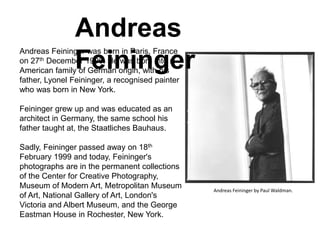
Photography: Andreas fieninger repeat
- 1. Andreas Feininger Andreas Feininger was born in Paris, France on 27th December 1906. He was born into n American family of German origin, with his father, Lyonel Feininger, a recognised painter who was born in New York. Feininger grew up and was educated as an architect in Germany, the same school his father taught at, the Staatliches Bauhaus. Sadly, Feininger passed away on 18th February 1999 and today, Feininger's photographs are in the permanent collections of the Center for Creative Photography, Museum of Modern Art, Metropolitan Museum of Art, National Gallery of Art, London's Victoria and Albert Museum, and the George Eastman House in Rochester, New York. Andreas Feininger by Paul Waldman.
- 2. In 1936 Feininger made the bold move of giving up architecture and moved to Sweden to focus on his Photography work. In advance on World War II, Feininger moved to the United States where he managed to establish himself as an individual photographer. By 1943 he had joined Life magazine, lasting 19 years, finishing in 1962. Andreas Feininger was born in Paris, France on 27th December 1906. He was born into n American family of German origin, with his father, Lyonel Feininger, a recognised painter who was born in New York. Feininger grew up and was educated as an architect in Germany, the same school his father taught at, the Staatliches Bauhaus. In 1936 Feininger made the bold move of giving up architecture and moved to Sweden to focus Early Years Staatliches Bauhaus, Weimar, Germany.
- 3. By 1943 he had joined Life magazine, lasting 19 years, finishing in 1962. In this time he completed more than 430 projects. The photographs were noticed for their harmony, balance and grand scale. As an architect, Fieninger had an eye for perfect angles and lines, thus enabling him to create dynamic images of the natural and man made world. Feininger become famous for his photographs of New York, Science and Nature, rarely showing an interest in Portraiture and People. Feininger had said that the city had attracted him since his earliest days as a photographer. But in time this love grew to include all the aspects of the city and its Professional Career The Bingham Canyon Mine
- 4. Feininger become famous for his photographs of New York, Science and Nature, rarely showing an interest in Portraiture and People. This happened when he moved to New York and was inspired by the differing architecture that constantly surrounded him. Image ry These images are typical of Feininger’s work, with lots of horizontal and vertical lines creating a modern feel. He often pictured the buildings in multiple
